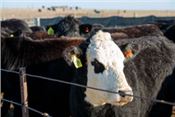Sticker-Shocking Feed Prices Require Wise Livestock Management

Cows in good body condition with supplemental hay should result in stronger calves at birth and a higher quality colostrum.
Photo by Matt Barton, UK Agricultural Communications Specialist
AIMEE NIELSON
PRINCETON, KENTUCKY
Feed prices are higher this fall than they were last year, and while that may initially cause “sticker shock,” a University of Kentucky extension specialist said that shouldn’t paralyze beef producers’ management decisions.
“The biology of our cows hasn’t changed since last year, and that means we still need to provide balanced nutrition for the outcomes we desire,” said Kevin Laurent, beef extension associate for the UK College of Agriculture, Food and Environment at the Research and Education Center in Princeton. “Producers can avoid the ‘sticker shock’ and avoid management paralysis.”
Laurent said if there ever was a time for producers to test hay, it is this year. In most cases, producers can work with their county extension agents to submit samples to the Kentucky Department of Agriculture's Forage Testing Program. They can plug the results into the UK Beef Cow Forage Supplement Tool available online at https://forage-supplement-tool.ca.uky.edu/ , to get supplement recommendations.
“You may find that your poorer hay will still meet the needs of dry cows in mid-gestation,” Laurent said. “Consider closing some gates and feeding weaned, dry cows hay now and saving stockpiled forage for closer to calving.”
Most years, stockpiled fescue tests 10 percent-12 percent crude protein and 60 percent-62 percent total digestible nutrients. Laurent said that amount will maintain lactating cows with little-to-no supplement.
Cows in good body condition with supplemental hay should result in stronger calves at birth and a higher quality colostrum.
“Make sure your cows are in body condition score 5-6 by calving time,” he said. “That means no visible backbone, hooks/hip bones or middle ribs. Continue to meet their nutritional needs after calving.”
Laurent warned that producers should not try use hay alone unless the hay tests well enough to maintain body condition.
“We know most of the time our hay is not sufficient on its own to get this done,” he said. “Just remember, how you manage prior to and after calving also affects the breed back rate and the 2023 calf crop – which may be the highest value of calves we have sold in recent years. Proper feeding could mean the difference between a 70 percent 2023 calf crop and a 90 percent 2023 calf crop. You always have to be looking farther down the road. The amount you spend on supplementing your hay this year could reap huge dividends in 2023.”
Producers should not abandon preconditioning and backgrounding programs this year. Laurent said the budgets for those still look favorable, even in the face of higher feed costs.
“Mainly, try to stay positive,” he said. “There’s lots of negativity out there; try to concentrate on the good. Times like these challenge us to do a little better and rethink some of our habits and management practices. Market dynamics are good. If we negotiate our way through these high input times, we can reap the benefits of better prices in the future.” ∆
Contents made available from University of Kentucky